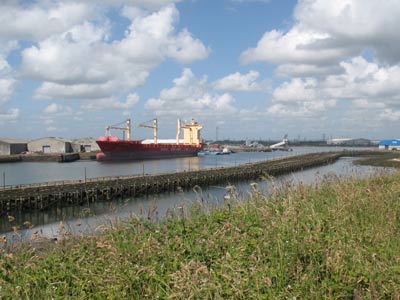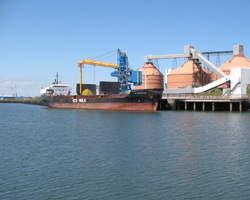
THE RIVER MOUTH AND BLYTH

"Blyth is very much a development of the later C19 and early C20. Growth came with the railways and the coalmines."
The Buildings of England, Northumberland. N. Pevsner. 1992.
The town of Blyth has a long history but owes its later development to the coal trade in the 19th century and the railways that grew to serve it. Salt making at nearby Cowpen and Cambois was of importance in earlier days together with fishing and coal pits. As waggonways were used to bring coal from Plessey to Blyth for shipment in the 18th century the port gradually developed with the construction of quays, breakwaters and piers to eventually become a proper dredged harbour. As the coalfield developed several staiths were built, shipbuilding and shipbreaking also became important and the town expanded fast. North Blyth also developed with coal staiths and later with the import of raw materials (bauxite and calcined petroleum coke) for the Alcan aluminium smelter at Lynemouth. Coal shipments peaked in 1961 when 6,889,317 tons were shipped. There was until recently a coal-fired power station. There are several wind turbines on the East Pier and more offshore. The town has undergone much redevelopment following the decline of its traditional industries. At Bebside and Bedlington, 3 miles upstream, a slitting mill and an ironworks were established bringing further trade to the river. With the decline of coal Blyth's shipments declined . The port now handles bauxite for the Alcan smelter at nearby Lynemouth, coal, forest products, containers, bulk and some general cargo. Blyth is the headquarters of the Royal Northumberland Yacht Club.
- Constructed - Sleekburn Gut staith - 1841
East breakwater 1857/62.
North Staiths - 1867?.
Deep-water quay and staiths, south side (North Eastern Railway)- 1872.
Low Quay staiths (North Eastern Railway) - 1884.
West breakwater -1885.
East breakwater extended - 1886.
Low Quay East statihs, south side (North Eastern Railway) - 1888.
North Side, additional staiths (North Eastern Railway) - 1896.
South Harbour - 1899. - Eastern breakwater extended 1908.
West Blyth staiths - 1928.
Additional South Side staiths - 1934. - Grid Ref: NZ 320 810


